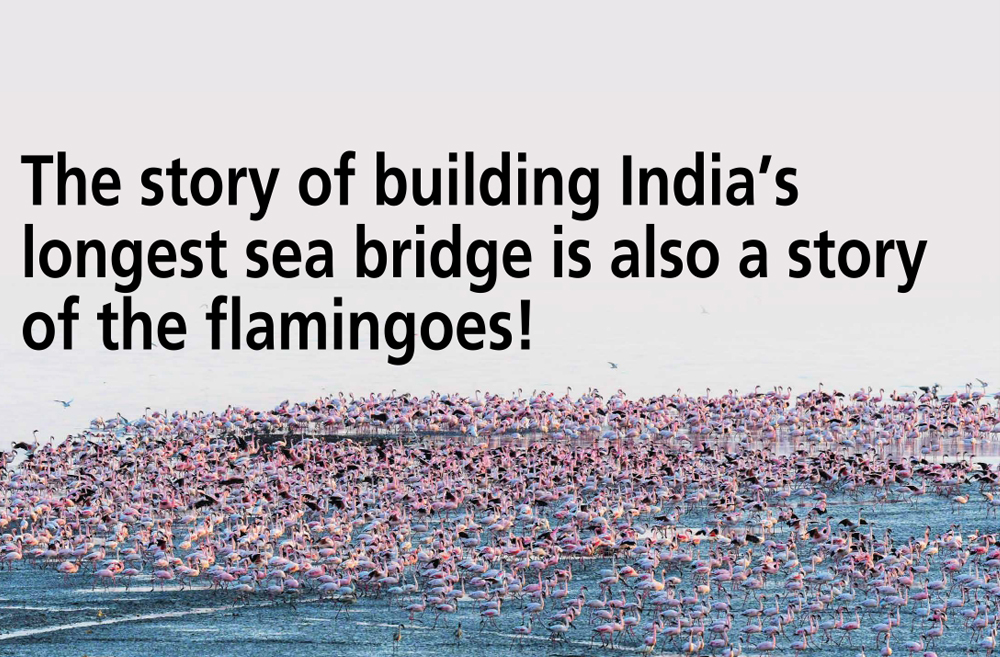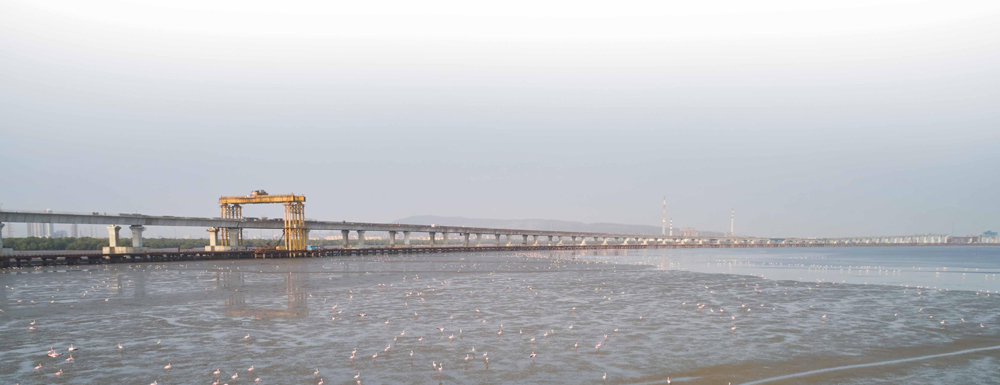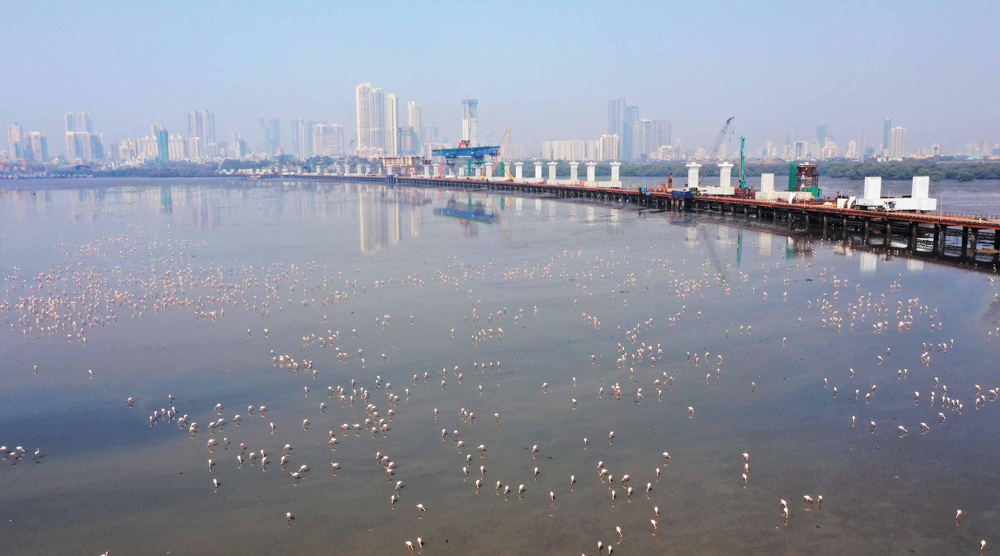
The ‘green’ side of the MTHL project
When Project Director Dr. Na, Deputy Project Director Sanjay Patil, Project Controller A Gopinath, and team took up the project to construct the Mumbai Trans-Harbour Link, little did they envisage the vital ‘green’ role that they would be playing. “The project passes through the Sewri mudflats which is an ecologically sensitive zone with a rich cover of mangrove trees,” explains Gopinath, “and one of our contractual obligations is to preserve the aquatic eco-system, to keep the flamingoes and other migratory bird species safe and their habitat untouched.”
Sewri, which enjoys the status of an Important Birding Area (IBA) for nature lovers, is home to the bright, pink-feathered flamingoes with their signature S-shaped necks; black-headed ibises; painted storks; reef egrets; great, intermediate, little egrets; striated herons; and pond herons. Another class of waders are international visitors and migrants like the sandpipers, greater and lesser sand plovers, Eurasian curlews, little stints, spotted and common redshanks, and bar-and black-tailed godwits.

The project passes through the Sewri mudflats, which is an ecologically sensitive zone with a rich cover of mangrove trees and one of our contractual obligations is to preserve the aquatic eco-system, to keep the flamingoes and other migratory bird species safe and their habitat untouched.
A Gopinath
Project Controller
Some 50,000 of these flamingoes migrate to the Sewri, Thane, and Ulwe stretch from Gujarat and West Africa for 6 – 7 months, touching a peak population of 24,300 in October 2021. Of the two varieties of flamingoes, the Lesser Flamingo are more dominant in India than the Greater Flamingo. They arrive with their young ones that are distinctive for their white and brown coats. Their coloration depends on the habitat and feed available, and in Sewri, they don beautiful dark pink feathers. The flamingoes feed on phytoplankton and zooplanktons while the other birds feed on snails, squids, shells, mollusca, prawns, amphipods, shrimps, fish larvae, crabs, worms, etc. that abound this region.
The adage that birds of a feather flock together holds true for the flamingoes, for hundreds of them can be seen flying around in long, curved flight formations. The fly zone is now included in the Central Asian Flyway, and the government has issued new protection rules for the flamingoes. Standing anywhere between 3 and 5 feet tall, these birds can ‘run’ on water with their webbed feet prior to take off. The brown and black-headed gulls share the Sewri mudflats with the flamingoes and look a lovely white speck on islands at low tide.
The black-headed ibises, painted storks and intermediate egrets are International Union for Conservation of Nature (IUCN)-listed birds under the IBA’s protection programme. The influence of these lovely birds is evident even in the pink hue of the bridge that is fast taking shape, stretching across the mudflats and the waters of the Arabian Sea. The project supports a study by the Bombay Natural History Society (BNHS) in the Ministry of Environment, Forest and Climate Change (MoEF&CC) special conditions and has also compensated the Thane creek project for a development programme of mangroves and flamingo walk. The technical team is supported by an environmental team functional at the MTHL-1 site – Ms. Devika Rani and Ms. Priyanka Singh.
The project team has taken several innovative steps to keep all these feathered friends safe and their habitats intact.

Special Piling Rigs (SPRs) for less noise and vibrations
For piling and drilling the permanent piles, the team has adopted world-class Reverse Drilling Machines that operate with minimum noise and vibrations that are less than 78 dBA and hence do not impact the aquatic life in the intertidal and marine work areas.
Less noise, lesser emissions
Special mufflers have been fitted to generators to reduce noise and carbon emissions. The sound is maintained at
72 dBA with the help of a generator silencer.

Special embedded lighting to avoid glare
Warm white colour, eco-friendly, LED Philips lights with 3,000 kelvin temperatures have been installed at site, which have an average surface illuminance of 30 lux, protecting the sensitive birds and aquatic life from the strong light rays.

Barricades protect the mangroves and birds from danger
To protect the flora around the site, specifically the mangroves area, a special sheet barricading has been erected to separate the construction area from the areas where the flora and birds live. The barricades at the sides of the bridge are also short to allow the birds to fly over the bridge.
A unique way to answer nature’s call
On a construction area that is spread over 10 hectares, answering nature’s call can be a difficult proposition, especially when dealing with a workforce of around 5,500. To address this issue, the site has put up Bio Toilets, a patented technology with inoculum, developed by DRDO. In this technology, zero sludge is generated, and the treated wastewater is discharged into drains after meeting the standards. Totally 36 Bio Toilets with bio digester tanks have been installed at site.
Efficient waste disposal
Pile muck generated during the construction of piles as a waste from the piling rigs is collected in separate bins and transported to a deposition area, that is, a designated location near the site that protects the marine body from the waste generated.

“Whether our efforts have been successful, only the flamingoes can say, but it is a fact that after we commenced construction activities here, the number of flamingoes coming to these mudflats has actually increased!”
Sanjay Patil
Project Director
The fabrication and construction over the seabed are carried out with special care to protect the sea from any foreign particles. These actions allow the aquatic life to follow their usual pattern of life that they used to before the commencement of the construction work. Some of these actions include waste collection at source, segregation, storage and transport of the waste to recycling units, and oil spillage sensors installed in Plant & Machinery.
In addition to these mitigatory steps, the project team must periodically conduct a series of tests to monitor the health of the environment.
Environmental Monitoring as a mitigation measure during the construction phase of the project has been in progress from 2018. NABET-qualified labs have been appointed with locations pre-qualified as per MoEF&CC guidelines to integrate the approved monitoring programme as follows:
Ambient air quality: Construction activity normally generates dust and emissions that harm the quality of air. Air quality meters installed at several sensitive locations monitor air quality on a weekly basis: PM2.5, PM10, SO2, NO2, O3, CO, Ni, As, and C6 H6. In addition, a sprinkler system in water tankers reduces dust pollution.
Ambient noise: To monitor noise levels at the construction site, several dosimeters have been installed, especially in the marine and intertidal zones. Noise levels are checked every fortnight.
Soil and sedimentation: Geological studies are carried out every quarter to check the soil quality and sedimentation process which occurs during high tide that is exacerbated by extended rains.
Marine ecology: Samples are collected from three zones – the mudflats, intertidal, and marine areas – and tested every quarter to monitor the species of phytoplankton and zooplankton in marine waters and benthic sediments to understand the productivity of the mudflats.

Marine water: The water quality is checked once a quarter on primary parameters like pH, DO, colour and odour, floating matter, suspended solids, oil & grease, and heavy materials.
Potable water: A filtration system has been installed to ensure the standard of drinking water as per the pollution control board’s requirement. Water is tested periodically every quarter at the office, site, yards, and labour camps and discussed with managers for site compliance.
“Whether our efforts have been successful, only the flamingoes can say,” smiles Sanjay Patil, “but it is a fact that after we commenced construction activities here, the number of flamingoes coming to these mudflats has actually increased!”
